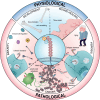uPARAP/Endo180: a multifaceted protein of mesenchymal cells
- PMID: 35460056
- PMCID: PMC9033714
- DOI: 10.1007/s00018-022-04249-7
uPARAP/Endo180: a multifaceted protein of mesenchymal cells
Abstract
The urokinase plasminogen activator receptor-associated protein (uPARAP/Endo180) is already known to be a key collagen receptor involved in collagen internalization and degradation in mesenchymal cells and some macrophages. It is one of the four members of the mannose receptor family along with a macrophage mannose receptor (MMR), a phospholipase lipase receptor (PLA2R), and a dendritic receptor (DEC-205). As a clathrin-dependent endocytic receptor for collagen or large collagen fragments as well as through its association with urokinase (uPA) and its receptor (uPAR), uPARAP/Endo180 takes part in extracellular matrix (ECM) remodeling, cell chemotaxis and migration under physiological (tissue homeostasis and repair) and pathological (fibrosis, cancer) conditions. Recent advances that have shown an expanded contribution of this multifunctional protein across a broader range of biological processes, including vascular biology and innate immunity, are summarized in this paper. It has previously been demonstrated that uPARAP/Endo180 assists in lymphangiogenesis through its capacity to regulate the heterodimerization of vascular endothelial growth factor receptors (VEGFR-2 and VEGFR-3). Moreover, recent findings have demonstrated that it is also involved in the clearance of collectins and the regulation of the immune system, something which is currently being studied as a biomarker and a therapeutic target in a number of cancers.
Keywords: Cancer; Collagen; Endocytic receptor; MRC2; Tissue remodeling; uPARAP/Endo180.
© 2022. The Author(s).
Conflict of interest statement
Not applicable.
Figures



References
Publication types
MeSH terms
Substances
LinkOut - more resources
Full Text Sources
Other Literature Sources
Research Materials
Miscellaneous

